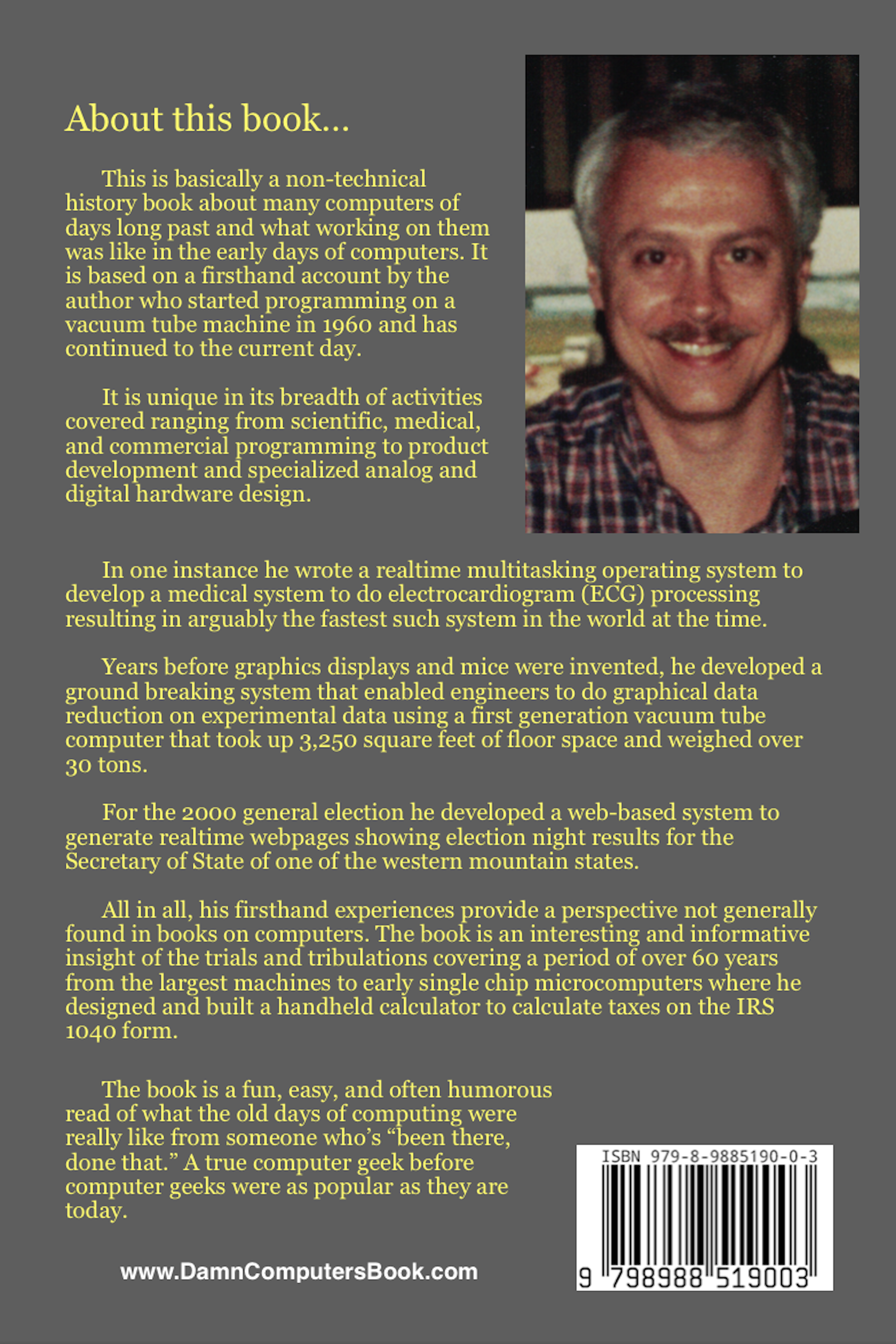The ideal gift book for anyone who has an interest in computers...


ISBN: 979-8-9885190-0-3
An excerpt from the book's foreword by Ron Eddy
|
One of the many reasons that John and I relate on a personal level is the similarity of our professional background.
While I followed a more traditional corporate route than he did, we were both there when the use of computers in science and industry really began to take off.
I went to work for IBM and was quickly sent to Basic Computer Training, a three month crash course in the theory and operation of digital computers.
After a year of on the job training I went back for another three month course, this one entitled Basic Systems Training.
We learned operating systems, systems programming, file design, telecommunications, and programming, from System/360 assembler to COBOL (which I disliked as much as John did.)
Upon completion of the class I was assigned a brand new IBM system, the 1130, which had been designed as an engineering solution.
IBM salesmen saw it as a low-cost entry for commercial applications and sold a lot of them.
The fact that there were no commercial applications available or that the only programming language available was FORTRAN (designed for scientists and engineers) were not seen as problems.
Readers will likely surmise John's native intelligence while progressing through the book, but he often writes as though his experiences were commonplace. They were not. As one who has been down the same path, I can assure you that John is being disarmingly modest when he casually says I bought the book, read about the system, and began programming it. Computer manuals, especially in the early days, were written as reference books, not tutorials. The authors assumed that you knew what you were doing and just needed a refresher. The books would give a technical description of, say, a computer instruction, with no hint as to why or where you might use it in a program. That part was up to you. After the design and coding phase, every system had a different and sometimes maddening program translation process. This process was intended to take your program from the written source code to an executable program. Heaven help you if your program did run but failed in execution. Supplied debugging aids were few. As John describes, a program failure often reduced the programmer to reading core dumps in octal or hexadecimal to determine the cause. Reading core dumps, watching the pattern of the console lights, or simply listening to the noises the computer made (yes, they did) were finely tuned skills of experienced programmers.
In addition, hidden dangers would lurk for those brave enough to delve into or interface with operating system routines, which John did on a regular basis. I find it remarkable that he gained all the necessary expertise on his own, which would have required a significant number of hours of concentrated effort. Sometimes when things didn't work right, you just kept working on them till they did. It was said of our profession that any of us who had not seen the sun rise over a cpu—the computer's central processing unit—couldn't truly be considered a programmer. Given John's experiences, I suspect that he saw many sunrises in that manner. Along the way he simply invented ingenious solutions to the problems he encountered. And finally, in my experience it is highly unusual for someone to be equally adept at all three levels of development: application programming, systems programming, and hardware design and implementation. Most people are content to focus on one and call for help if in trouble with either of the others. Except, of course, for John.
As authentic dinosaurs, veterans of the early days of the computer revolution, John and I have traded many war stories. Through the years I gained some insights into John's personal and technical history, but this book filled in many gaps and added new experiences. At one level, John's story is a history of nearly sixty years of computing, beginning with vacuum tubes, core memory, and hand-soldered components. You can follow advances in the science of computers, both hardware and software, from the beginning of his career to the end. And then, on another level, you can come to understand John's work history, which is varied and wide-ranging. Both perspectives, in my view, are informing and fascinating. |
John's first computer, the UNIVAC 1105 vacuum tube machine.

A single-chip calculator John designed for a friend to do a complete IRS Form 1040.

The contents of this website are
Copyright © 2023 John B. Eichler
All rights reserved.